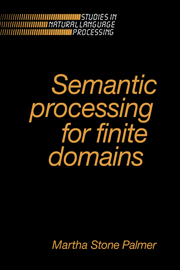2 - Previous computational approaches to semantic analysis
Published online by Cambridge University Press: 24 November 2009
Summary
The preceding chapter presented the basic difficulties associated with producing semantic representations of sentences in context. This chapter surveys several well-known natural language processors, concentrating on their efforts at overcoming these particular difficulties. The processors use different styles of semantic representation as well as different methods for producing the chosen semantic representation from the syntactic parse. Ideally, clearly defined methods of producing semantic representations should be based on a linguistic theory of semantic analysis; a theory about the relationships between the given syntactic and semantic representations, and not just on the particular style of semantic representation. Computational linguistics has a unique contribution to make to the study of linguistics, in that it offers the opportunity of realizing the processes that must underlie the theories. Unfortunately, it seems to be the case that those systems that adhere most closely to a particular linguistic theory have the least clearly defined processing methods, and vice versa.
Another important aspect to examine is whether or not any of the methods make significant use of procedural representations. An important contribution hoped for from computational linguistics is an understanding of procedural semantics as “a paradigm or a framework for developing and expressing theories of meaning” [Woods, 1981, p. 302]. It is argued that adding procedures to a framework should greatly enrich its expressive power [Wilks, 1982]. In spite of the intuitive appeal of this argument, much work remains to be done before the benefits can be convincingly demonstrated.
- Type
- Chapter
- Information
- Semantic Processing for Finite Domains , pp. 30 - 67Publisher: Cambridge University PressPrint publication year: 1990



